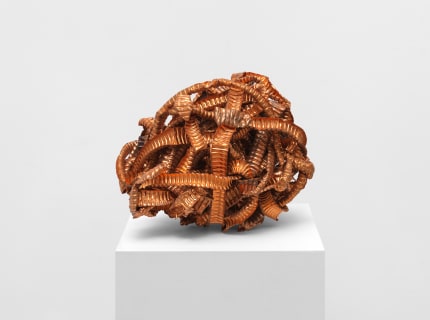An artist long prominent in his home of Dubai, in the United Arab Emirates, Hassan Sharif recently established an international reputation after a solo show of his work inaugurated the U.A.E. pavilion at the 2009 Venice Biennale. Sharif, 62, is known for his evocative and provocative conceptual pieces, as well as paintings, works on paper and sculptures, produced since the early 1980s. A selection of recent works currently at Alexander Gray Associates in New York, his second solo with the gallery (through Feb. 8), offers a concise overview. Included are several small abstract drawings and paintings, plus seven large wall reliefs and free-standing sculptures.
Using a grid format in the drawings, Sharif presents rows of ink marks that appear to be part of an esoteric alphabet, albeit one the artist has invented. He isolates one or more of these ciphers in the paintings. The three-dimensional works here are fabricated from found objects, including rags, wire, strips of metal, bent spoons and wood. All of them incorporate the process of weaving, which corresponds to ancient Middle East craft traditions of textile and carpet manufacturing. Despite the abject materials and rough-hewn construction, each of Sharif’s sculptures conveys a systematic unity and formal elegance.
Offering an insight into his process and approach, Sharif recently gave A.i.A. a tour of the exhibition.
DAVID EBONY Can you describe your process in the drawings?
HASSAN SHARIF I think of these markings as more of an engagement than an arrangement. The series starts randomly. But then I give the marks a kind of order, by lining them in rows and then expanding the series by progressively adding a line or two to each mark. Eventually, I remove a line as the series progresses, until I make just a single line. The important thing is the process.
I have used these like pages of a performance script or musical notation, for performances I did in London in the early 1980s. Each mark would suggest a simple action. For instance, I speak while my mouth is full of bread. I take a sip of water. I eat more bread, speak, drink some more water, and so on, recording all the sounds. All the while I’m talking about serious things like politics and art, but it’s an ironic delivery, imitating politicians and lecturers. There would be only three or four people in the audience-mostly friends or other artists.
EBONY It sounds like a Fluxus performance.
SHARIF Yes, of course. I love Fluxus. Most of my work builds upon the simple procedure I use in the drawings.
...
Read full interview at artnews.com.

